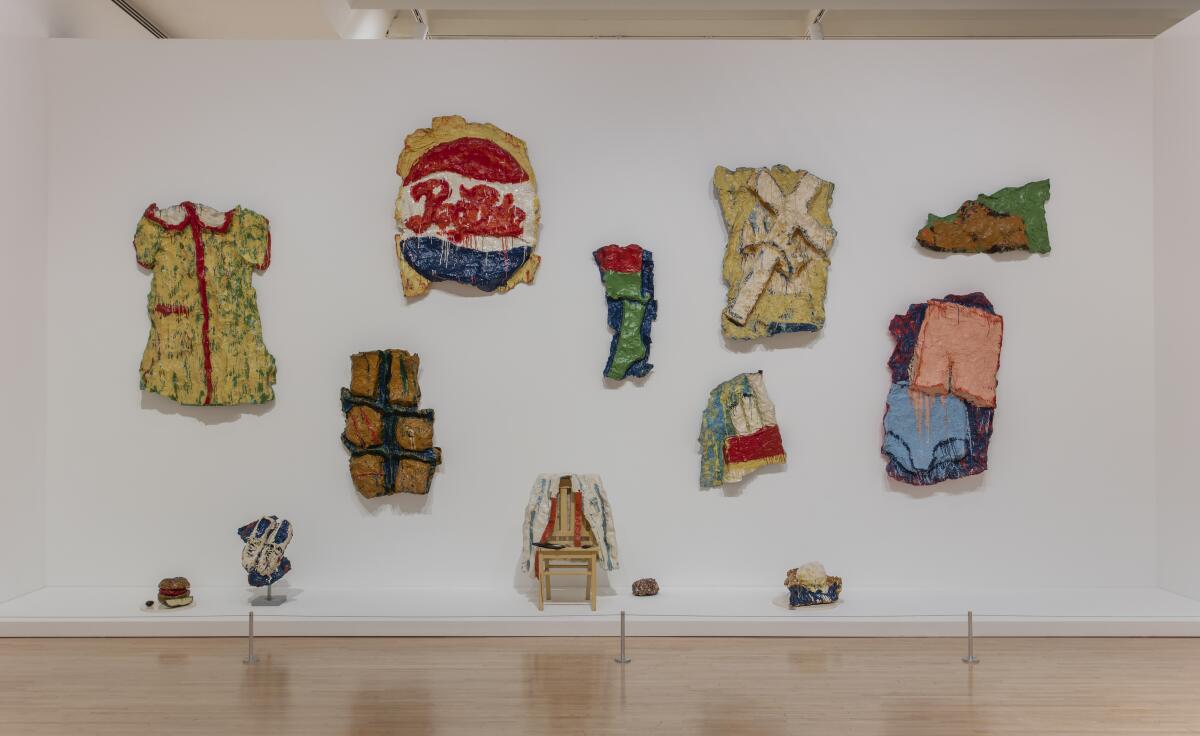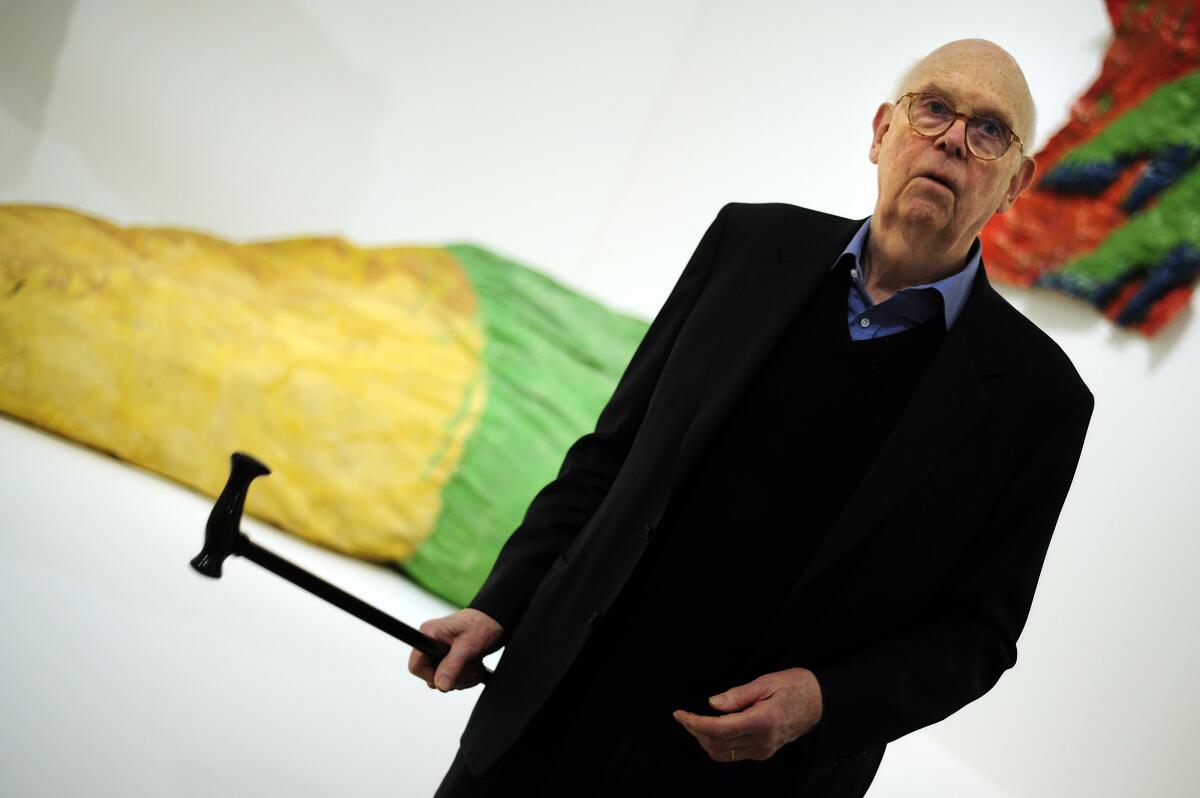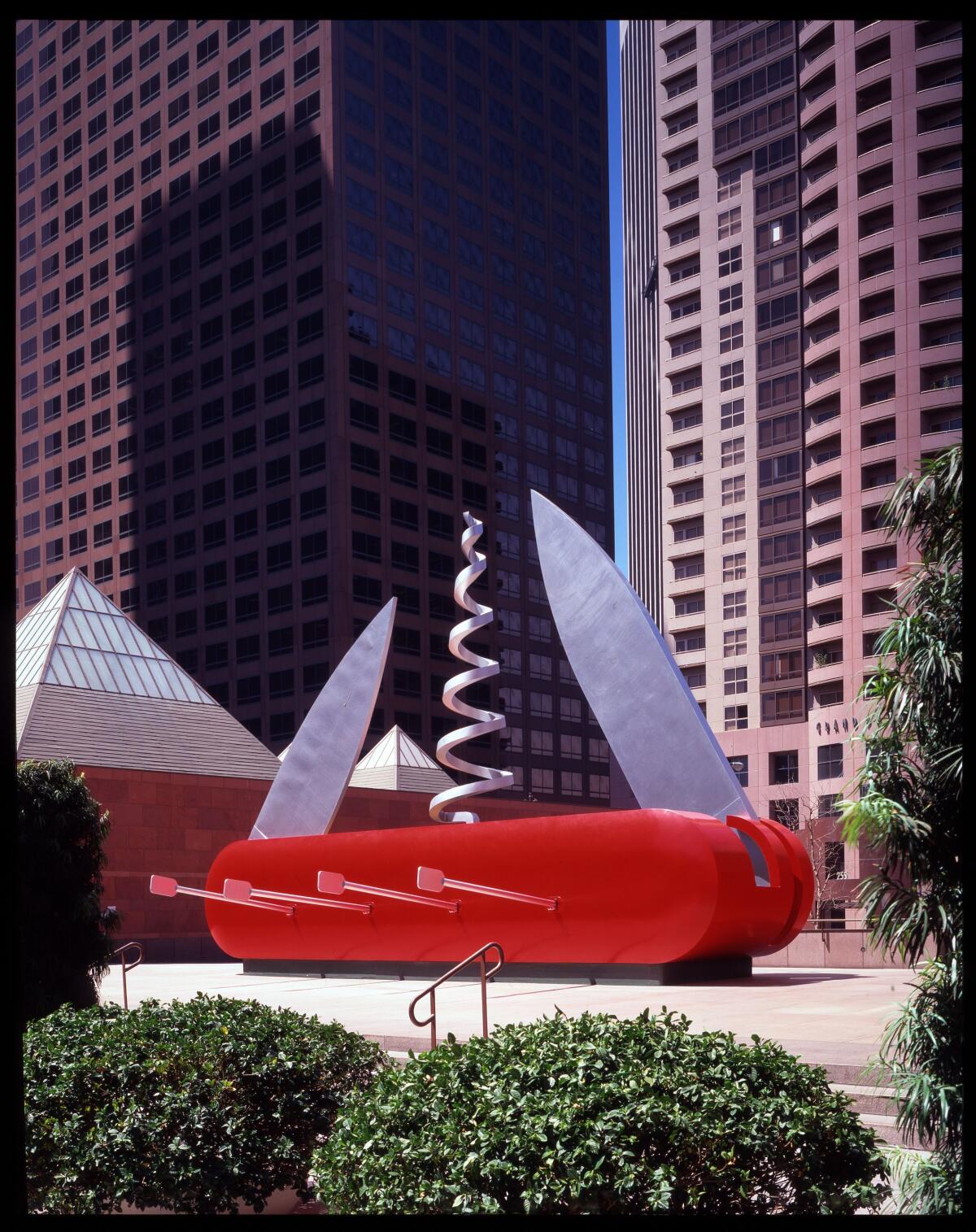Appreciation: For sculptor Claes Oldenburg, art was the soul of Pop

- Share via
For more than a quarter-century, a Claes Oldenburg sculpture stood as a side-street landmark in West Hollywood. An enormous stainless-steel knife blade, 6 feet tall and 12 feet long, sliced down from the roof of a vernacular building on North Hilldale Avenue, jutting out toward the street.
The shiny silver blade, cutting through the center of the façade, curled back sheets of gray stucco on both sides. The composition looked like the prow of a ship moving steadily ahead through water.
Or, like a cake being sliced, as the artist told Times reporter Suzanne Muchnic when the snazzy sculpture was unveiled in 1989, its architectural flourish like frosting decorating the building. Oldenburg, the witty and prolific Pop sculptor who died Monday in New York at 93, had an uncanny ability to layer provocative references through a precise selection of ordinary objects as his sculptural motifs.
Hamburger, Pepsi-Cola sign, athletic shoe, scissors, Pentecostal cross, three-way plug, underpants — these mundane items and more, most fabricated in plaster and slathered with colorful brushy paint, are among the nearly three dozen of his sculptures, drawings and multiples in the collection of Los Angeles’ Museum of Contemporary Art. They form one of the largest groups of his important contribution to art in the second half of the 20th century.

Popular culture is regularly misunderstood as the subject of Pop art, but Oldenburg knew that art culture is its actual focus. A core of his stellar achievement was his capacity to reveal art’s operations circulating within the spectral media-maze of contemporary society. His acutely identified popular forms are merely the contemporary language for its delivery.
For example, the 1976 American Bicentennial celebration in Philadelphia — a commission with a rather high profile, government monuments having been long out of fashion for major art — saw him fabricate a masterpiece. The huge, 45-foot upright “Clothespin” is just like the ones in your laundry basket — with a few striking contextual differences. The erect pair of wooden pins, here fabricated from industrial Cor-ten steel, echoes (and outdoes) the famous, 37-foot standing bronze figure of William Penn visible atop nearby City Hall, made in 1890 by sculptor Alexander Milne Calder. The two pins are held together in an embrace by the coiled spring, also evoking the 1916 form of the smooching couple in “The Kiss,” a treasure in the Philadelphia Museum of Art down the street, carved from limestone by Constantin Brancusi, arguably the greatest Modern sculptor.
The graceful line of Oldenburg’s coiled spring pulls everything up to date, artfully and patriotically suggesting the number “76.” A century of sculpture is absorbed.
The knife over in West Hollywood had been commissioned for the façade of the sculpture annex of Margo Leavin Gallery on the next block, where the Stockholm-born, Chicago-raised and New York-based Oldenburg showed numerous times over the years. (The sculpture was removed after the gallery closed in 2013.) His reference to cake slicing implied a party dimension, suitable for an art exhibition’s opening celebration.
He had been making cake sculptures since at least 1962, when his first wife, artist Patty Mucha, helped sew yards of canvas stuffed with foam rubber and cardboard into the form of a giant chocolate slice of it for a pillowy soft sculpture that stands on the floor. (More than 9 feet long, it’s big enough for a futon.) And knives had been integral to his work since 1966, when he proposed a monumental one that would seem to cut open a London building at the busy shopping intersection of Oxford and Regent streets, preparing the stores’ contents to spill out on the sidewalk. (The project never came to pass.)
Closer to home, Oldenburg collaborated several times with Los Angeles architect Frank O. Gehry, including for the design and fabrication of a huge Swiss Army knife with enormous blades and a corkscrew spiraling skyward like a cartoonist’s squiggle signifying craziness. Together with art historian Coosje van Bruggen, Oldenburg’s second wife, it was constructed to double as a boat to navigate the preposterous yet charming canals of Venice, Italy, as part of an elaborate performance piece. With the famously all-purpose mutability of a Swiss pocketknife, ever at the ready, it made manifest the multiple allusions offered in Oldenburg’s art.

Over on Hilldale Avenue, the wave-parting flourish of a knife cutting down the stucco façade also suggested a dramatic opening up of a modern art gallery. Hollywood-driven popular culture dominates contemporary society, while art culture stands over to the side, occupying a somewhat cloistered space in daily life. Oldenburg turned the inside out.
“I am for the art that a kid licks, after peeling away the wrapper,” he once explained. Oldenburg’s embrace of ordinary objects to get to the heart of the matter fit perfectly with Gehry’s architecture of everyday materials, like chain-link fence and plywood, deployed as the eye-opening stuff of actual art.
The two worked together on an advertising agency’s Venice offices, where Oldenburg contributed a hilarious pair of giant binoculars that function as a triumphal arch, consecrating the driveway into the underground parking garage, as if that were the modern world’s version of ancient Hades; and, with Van Bruggen, the campus of Loyola Law School downtown, where the artists’ self-descriptive “Toppling Ladder With Spilling Paint” — a sculpture notably wrapped in oversize chain-link — slyly warns students of the legal profession against accidentally making a terrible mess of things.
That chance activity is reserved for art and artists. They get to be the messy and experimental ones. Over and over, Oldenburg made Pop sculptures that had art lurking inside. Art is the ghost lurking in L.A.’s global pop culture machine, and Oldenburg cut it loose.
More to Read
The biggest entertainment stories
Get our big stories about Hollywood, film, television, music, arts, culture and more right in your inbox as soon as they publish.
You may occasionally receive promotional content from the Los Angeles Times.











